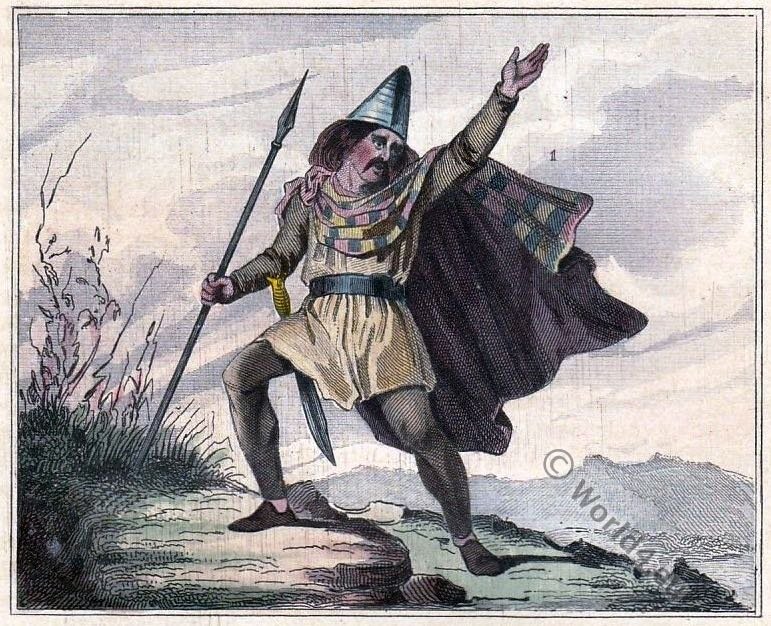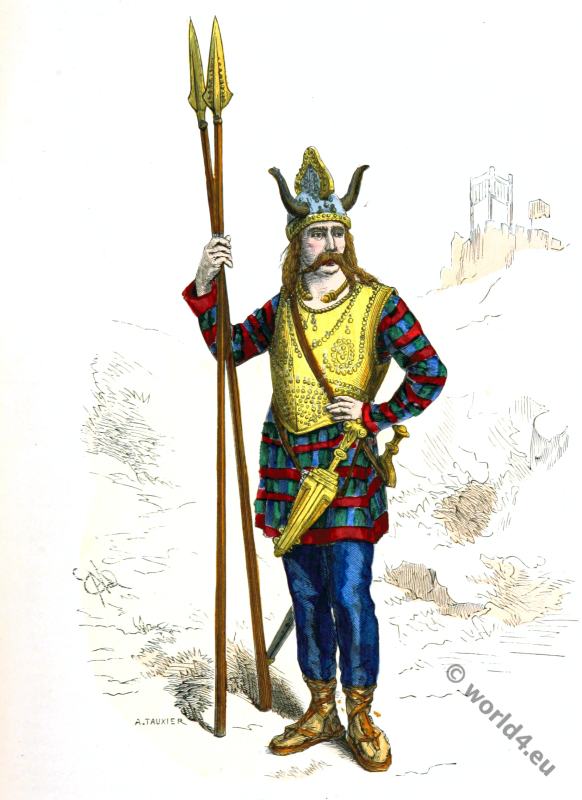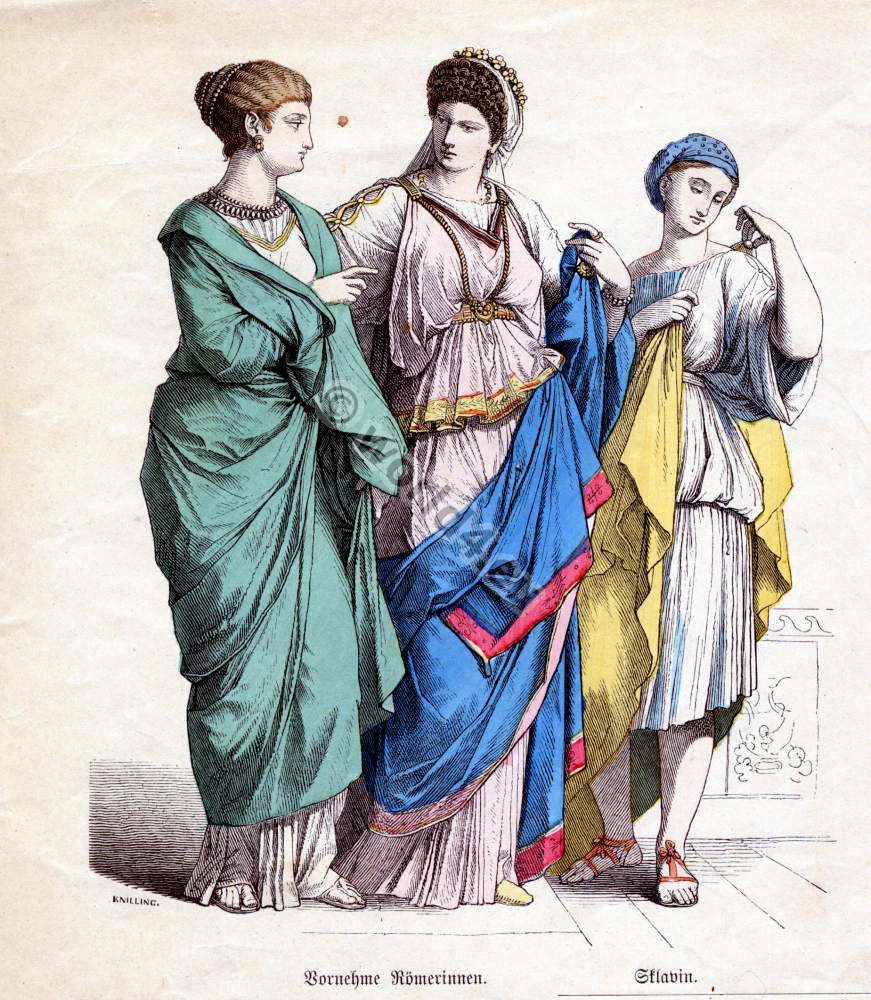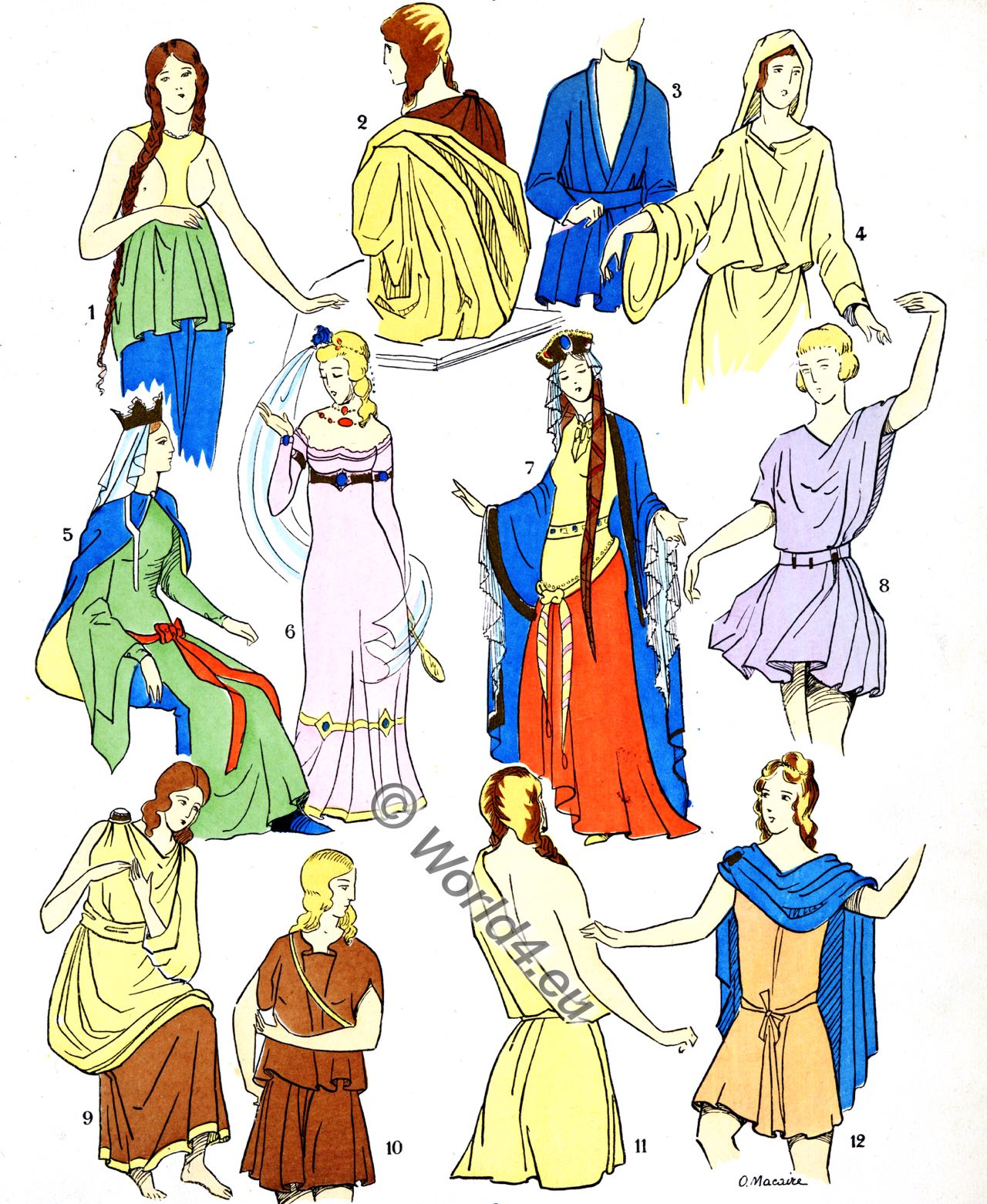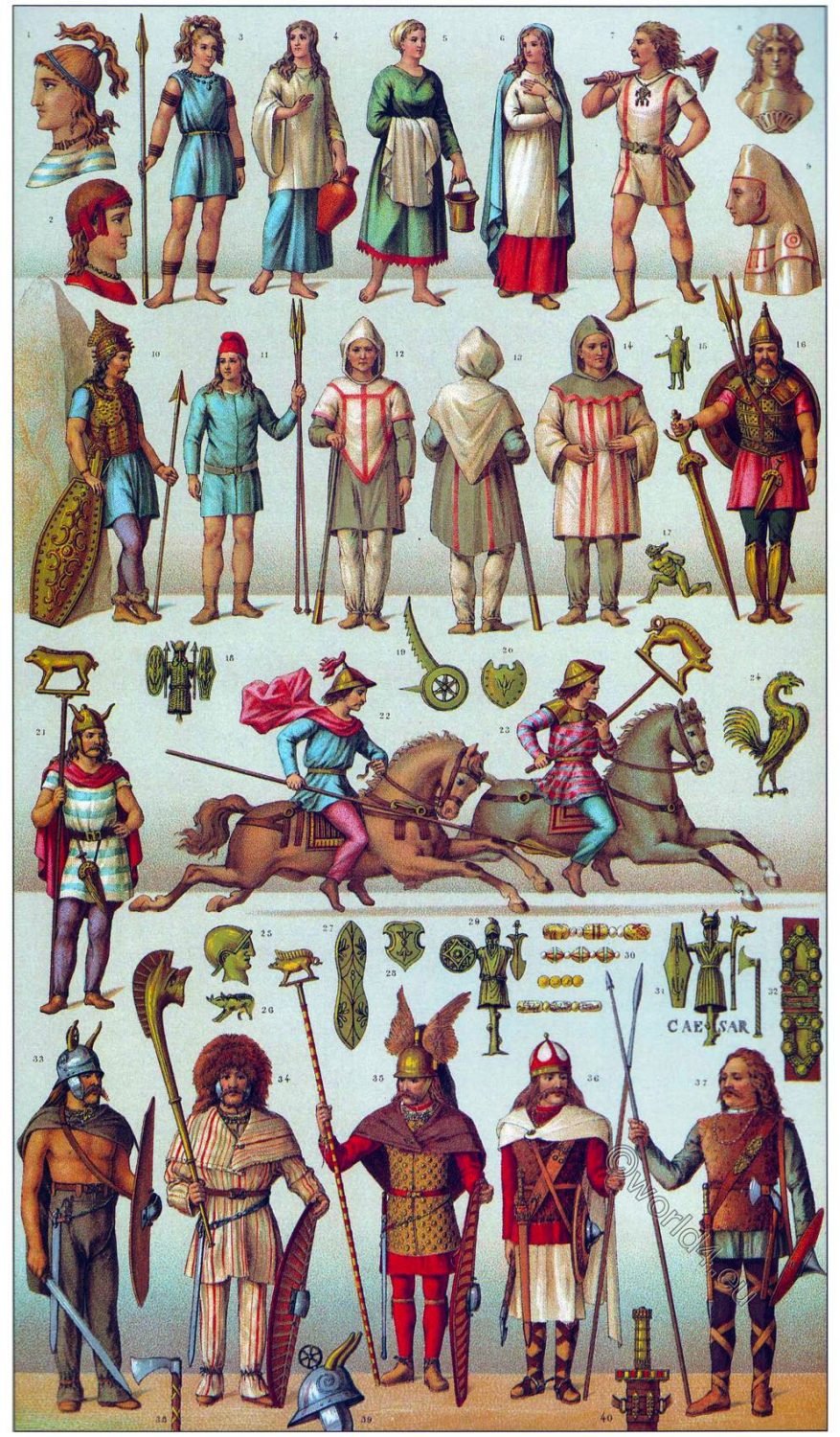
GAULS.
THE INHABITANTS OF GALLIA BEFORE THE ROMAN CONQUEST. WARRIOR TYPES OF THE SALIAN FRANKS.
DOUBLE PANEL.
After the Gauls, descendants of the Gaelic and Kymrian (Celtic) tribes, had for a time filled Europe with the glory of their weapons, they found themselves in a state of weakness since the second and third centuries before our reckoning, which made them defenceless against the Germanic invasions and made it much easier for the Romans to conquer the country, which had begun in 125 BC.
The findings from the Bronze and Iron Age correspond throughout to the common Celtic type. From the beginning of the third century B.C., a special luxury in precious metals became noticeable, which testifies to the wealth of the country at that time.
After the last unfortunate war of independence under Vercingetorix (ca. 82 B.C.; † 46 B.C. in Rome), Roman costume and custom became general in Gaul.
Gauls. Male types.
- No. 1 and 2. Chiefs, after bronze coins. No. 1 bears the name of the Sutticos of Rouen, an Arcantodon, or chief of the Veliocassen at the time of Caesar. Hair taken up and knotted over the head crest. War skirt with horizontal stripes.
- The Carnut chief (also known as Carnuti) No. 2 wears the drooping hair wrapped in a triple bandage tied at the side. The necklace consists of a row of coloured beads.The inscription shows the name Catal (published by Hucher in the Art de gaulios).
- No. 3. Warrior. Arranged after old patterns. War skirt without sleeves as on the bas-reliefs of the Trajan Column. Taken up and knotted hair. Bracelets after the necklace preserved in the museum in Vannes.
- No. 7. Farmer. Compilation.
Vergata, skirt with vertical stripes, with buckle belt after a statuette fragment from the Edmond Tudot collection in the museum in Moulins. Necklace with pendants, in the museum at Saint-Germain. Stone axe or hoe. Matching ankle boots. - No. 10. Warrior leaning against a menhir. Composition. Helmet, allegedly from Falaise, in the Louvre Museum. Armour with chased and dotted ornaments. Torques (choker), found in the churchyard of Crons, near Vertus in the Champagne region. Sword from the Troyon collection, published by Ed. Charton in his Histoire de France. Lance after that of the standard-bearer on the reverse of a coin of Espasnactus or Lucterios, a chief of the Arverner (Hucher collection). Shield after the bas-reliefs of the triumphal arch of Orange. Trousers as worn by the prisoners on the sarcophagus relief of the Vigna Amendola (Ammendola sarcophagus of the Capitoline Museum in Rome). Gallica, shoe with thick sole, laced over the instep.
- No. 11. Armed farmer. Compilation.
Phrygian cap, as on two bronze statuettes, found at Autun 1875 and at Tournay. Way of wearing the belt after the statuettes of Moulins. Caracalla or palla gallica with long sleeves, imported from Gaul to Rome by the Emperor Marcus Aurelius Antoninus, called Elagabal (204-222) (originally called Varius Avitus Bassianus). Two lances with long tip. Footwear like no. 7. - Nos 9, 12, 13 and 14. Farmers. Different species of Bardocucullus.
The Bardocucullus is a hooded cloak made of felt. Nos. 12 and 13 show the same figure from two sides. In no. 14 the Bardocucullus is only a cap covering the head and shoulders. No. 9 depicts the god Risus. Nos. 12, 13 and 14 have been reconstructed according to the statuettes of the museum in Moulins. - No. 16. Warrior. Compilation.
Helmet, found 1872 in Berru by Monsieur of Barthélemy. Ornaments of the armour after those of one found in Alise in Franche-Comté. Two spears and round shield hanging on straps over the back. Dagger after the one found at Brenzolo near Guingamp in the department of Côtes-d’Armor. Splints, as on the above mentioned coin of Espasnactus. Broad two-handed sword after the Gallo-Italian grave finds of Sesto Calende (Golasecca culture) in Italy. - No. 21. Flag Bearer of the foot troops. Composition.
The Gallic golden boar serves as the standard. Helmet with horns and wheel as helmet decoration after the reliefs of the triumphal arch of Orange. Striped war coat. Triangular dagger hanging from the belt. Trousers laced over the ankle. War coat similar to the sagnum, the Roman. - No. 22 and 23. Horsemen.
The illustrations are drawn after the coins published by Eugène Hucher in his style gaulois *). No. 22, in silver, bears the head of Litavicus, the chief of the Aedu, no. 23, in bronze, with the inscription Cicüdu Bei. The harness of the horses is borrowed from fragments of terracotta statuettes from the Tudot Collection.
*) L’art gaulois, ou, Les Gaulois d’après leurs médailles par Eugène Frédéric Ferdinand Hucher (1814-1889).
- No. 33 and 39. Armed Warrior. Illustration after the sculptures of the triumphal arch of Orange.
Iron cap with horns, wheel and cheek pieces (compare No 39).
The sagulum, fastened with an agraffe, leaves the naked upper body free. Necklace made of small round pearls. A leather belt holds the woolen trousers laced over the ankle. Shoes with thin sole. The scabbard hangs on a chain, the iron blade has a central ridge. The round, leather covered wooden shield is attached to a strap and has an iron hump. - No. 34. Warrior with the carnyx, war trumpet.
The carnyx is a bronze signal horn, sounding much wider than the buccina of the Romans.
Iron cap with cheek-pieces, above a wide fur cap. Skirt and trousers striped, above the former a kind of shoulder coat made of the same fabric. Belt, sword and shield like no. 33. - No. 35. Gallic chief with field mark. Addition after the coin of the Verotal.
Helmet made of gilded bronze with hair bush and birds of prey wings. Leather skirt, sleeveless, heavy leather, with bronze buttons. Shoulder cloak. Belt with sword chain. Red caracalla and similar trousers with leather garters under the knee. The painted and humped wooden shield is hexagonal like the one pictured under no. 10. - No. 15, 17, 18, 19, 20, 24, 25, 26, 27, 28, 29 and 31. Additional parts borrowed from numismatics.
- No. 15 – Soldier, the shield on the back like No. 16, after a Galatian coin (Galatia, Celts), published by Smith in his Dictionnaire de biographie et de mythologie.
- No. 17 and 18 – Reversal of a Caesar coin. The bound prisoner is beside the trophy.
- No. 19 – Sickle chariot from a Caesar coin, next to a trophy of Gallic weapons.
- No. 20 – Pelta-like shield from a trophy of a Caesar coin.
- No. 24 – Rooster in fighting position from the reverse of a Greek coin with the image of Athena.
- No 25 – Keltiberian helmet from a Gallic coin with the image of Carmo (now Carmona), a fortified city in Hispania Boetica.
- No. 26 – Boar in fighting position, coin of the city of Avenio (Avignon).
- No. 27 – Shield from a trophy of a Caesar coin (No. 19).
- No. 23 and 29 – Shield and trophy from a commemorative coin of Caesar’s triumph.
- No 31 – Trophy of Gallic arms, commemorative coin on the triumph of Caesar.
Gallic Women.
- Nos. 4, 5, 6 and 8.
No. 4 is reproduced after a statuette from the Tudot collection found in the Clermont, Moulins and Vichy area. Freely flowing hair, tunic with long wide sleeves, bare feet, a Gallic vase in the hand. - No. 5 – Published by Dom Martin in his Religion of Gaulois. Clothing similar to that of today’s peasant women.
- No. 6 – Reproduced after the prisoners of the Arc de Triomphe of Orange. Two tunics over each other, pallium, shoes.
- No. 8 – Hairstyle after a medallion from the museum in Moulins, depicting Apollo Belenus. This hairstyle was peculiar to women serving at table (acercomes).
After the Roman conquest, the Gaulish women preferred to wear the Greek costume (corymbus, anadema, diadema). Widows and older women wore the cloak, the end of which was pulled over the back of the head. On great feast days they covered their heads with a kind of tiara; their hair rested in a gold net and was powdered with ashes. All kinds of cosmetic products and make-up were in use. The women of the people wore long skirts and aprons. The bodices were low-cut, the arms naked.
FRANKISH WARRIORS.
- No. 36. Merovingian chief.
- Nos. 30, 38 and 40. details of his armour.
Completed after the finds of a grave in Pouan, Aube department. The helmet consists of a leather cap with bronze ring. Short tunic with open sleeves and a kind of Scottish apron. The footwear is held by wide bands crossing around the leg. Iron spurs with tip. A wide leather band holds the sword with a painted wooden scabbard (compare No. 40). The war cloak partly covers the necklaces (compare No. 30). The shield with iron hump hangs from a leather strap. The hand holding the lance is decorated with rings. No. 38 shows the detail of the Frankish battle axe in the right hand. - No. 37 Frankish warrior.
No. 32. Detail of his armour. The armament consists of the Scamasax, the throwing spear and the Frankish battleaxe. The clothing without coat and apron is similar to that of the chief No. 36. No. 32 gives the detail of the buckle of the bandelier holding the Scamasax. The head with long falling hair is uncovered.
Nos. 1, 2, 3, 4, 5, 6, 7, 8, 9, 10, 11, 12, 13, 14, 16. 21, 22 and 23 are thanks to the communications of Mr Henri du Cleuziou. Nos 30, 32, 33, 34, 35, 36, 37, 38, 39 and 40 belong to the ethnographic and military collection of the Artillery Museum in Paris and are reproduced from photographs. Nos 17, 18, 19, 20, 27, 28, 29 and 31, where the origin is not explicitly stated, are taken from the Romanae et Graecae antiquitatis monumenta of H. Goltzius, Antwerp, 1608.
Cf. Amédée Thierry, Histoire des Gaules depuis les temps les plus recules, 1857. – Henri Martin, Histoire de France. Eugène Hucher, L’Art Gaulois ou les Gaulois d’après les médailles, 1869-74. Quicherat, Histoire du costume en France. E. Bosc und L. Bonmemère, Histoire nationale des Gaulois sous Vercingétorix, 1882.
Source: History of the costume in chronological development by Auguste Racinet. Edited by Adolf Rosenberg. Berlin 1888.
Continuing

